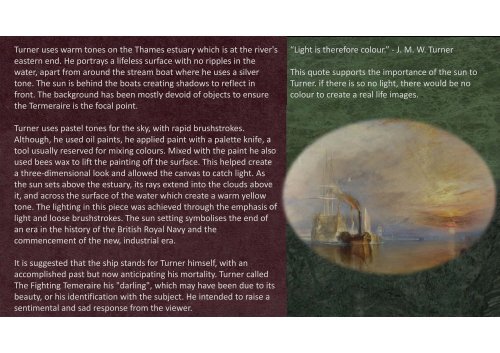Create successful ePaper yourself
Turn your PDF publications into a flip-book with our unique Google optimized e-Paper software.
Turner uses warm tones on the Thames estuary which is at the river's<br />
eastern end. He portrays a lifeless surface with no ripples in the<br />
water, apart from around the stream boat where he uses a silver<br />
tone. The sun is behind the boats creating shadows to reflect in<br />
front. The background has been mostly devoid of objects to ensure<br />
the Termeraire is the focal point.<br />
“Light is therefore colour.” ‐ J. M. W. Turner<br />
This quote supports the importance of the sun to<br />
Turner. if there is so no light, there would be no<br />
colour to create a real life images.<br />
Turner uses pastel tones for the sky, with rapid brushstrokes.<br />
Although, he used oil paints, he applied paint with a palette knife, a<br />
tool usually reserved for mixing colours. Mixed with the paint he also<br />
used bees wax to lift the painting off the surface. This helped create<br />
a three‐dimensional look and allowed the canvas to catch light. As<br />
the sun sets above the estuary, its rays extend into the clouds above<br />
it, and across the surface of the water which create a warm yellow<br />
tone. The lighting in this piece was achieved through the emphasis of<br />
light and loose brushstrokes. The sun setting symbolises the end of<br />
an era in the history of the British Royal Navy and the<br />
commencement of the new, industrial era.<br />
It is suggested that the ship stands for Turner himself, with an<br />
accomplished past but now anticipating his mortality. Turner called<br />
The Fighting Temeraire his "darling", which may have been due to its<br />
beauty, or his identification with the subject. He intended to raise a<br />
sentimental and sad response from the viewer.





